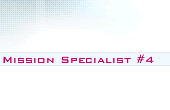|
 Dr. Richard Linnehan will perform his delicate and complicated Hubble
servicing tasks with the skill of a surgeon. That's because he is
a surgeon-a veterinarian, to be exact. With a Bachelor of Science
degree in animal sciences and a Doctorate in Veterinary Medicine,
Linnehan's specialty is exotic animals. (Hubble certainly qualifies
as his most exotic surgical patient.) .
Dr. Richard Linnehan will perform his delicate and complicated Hubble
servicing tasks with the skill of a surgeon. That's because he is
a surgeon-a veterinarian, to be exact. With a Bachelor of Science
degree in animal sciences and a Doctorate in Veterinary Medicine,
Linnehan's specialty is exotic animals. (Hubble certainly qualifies
as his most exotic surgical patient.) .
 After graduating from veterinary school, Linnehan entered private
practice. Later, he was later accepted to a 2-year joint internship
in zoo animal medicine and comparative pathology at the Baltimore
Zoo and The Johns Hopkins University. After completing his internship,
he was commissioned as a Captain in the U.S. Army Veterinary Corps
and served at the Naval Ocean Systems Center, San Diego, California,
as chief clinical veterinarian for the US Navy's Marine Mammal Program.
In 1992, he was selected by NASA to begin astronaut training. He
is a veteran of two spaceflights and has logged more than 787 hours
in space.
After graduating from veterinary school, Linnehan entered private
practice. Later, he was later accepted to a 2-year joint internship
in zoo animal medicine and comparative pathology at the Baltimore
Zoo and The Johns Hopkins University. After completing his internship,
he was commissioned as a Captain in the U.S. Army Veterinary Corps
and served at the Naval Ocean Systems Center, San Diego, California,
as chief clinical veterinarian for the US Navy's Marine Mammal Program.
In 1992, he was selected by NASA to begin astronaut training. He
is a veteran of two spaceflights and has logged more than 787 hours
in space.
 Linnehan first flew as a mission specialist in 1996 on STS-78, the
Life Sciences and Microgravity Spacelab (LMS) mission. The longest
Space Shuttle flight to date, this 17-day mission included studies
sponsored by ten nations and five space agencies. It was the first
mission to combine both a full microgravity studies agenda and a
comprehensive life sciences payload.
Linnehan first flew as a mission specialist in 1996 on STS-78, the
Life Sciences and Microgravity Spacelab (LMS) mission. The longest
Space Shuttle flight to date, this 17-day mission included studies
sponsored by ten nations and five space agencies. It was the first
mission to combine both a full microgravity studies agenda and a
comprehensive life sciences payload.
 In 1998, he served as the payload commander on the STS-90 Neurolab
mission, his second Spacelab mission. This 16-day flight measured
the effects of microgravity on the brain and nervous system. The
seven-person crew served as both experiment subjects and operators
for 26 individual life science experiments focusing on the effects
of microgravity on the brain and nervous system. His crewmates included
Scott Altman, who joins him again as Mission Commander on STS-109.
In 1998, he served as the payload commander on the STS-90 Neurolab
mission, his second Spacelab mission. This 16-day flight measured
the effects of microgravity on the brain and nervous system. The
seven-person crew served as both experiment subjects and operators
for 26 individual life science experiments focusing on the effects
of microgravity on the brain and nervous system. His crewmates included
Scott Altman, who joins him again as Mission Commander on STS-109.
|

